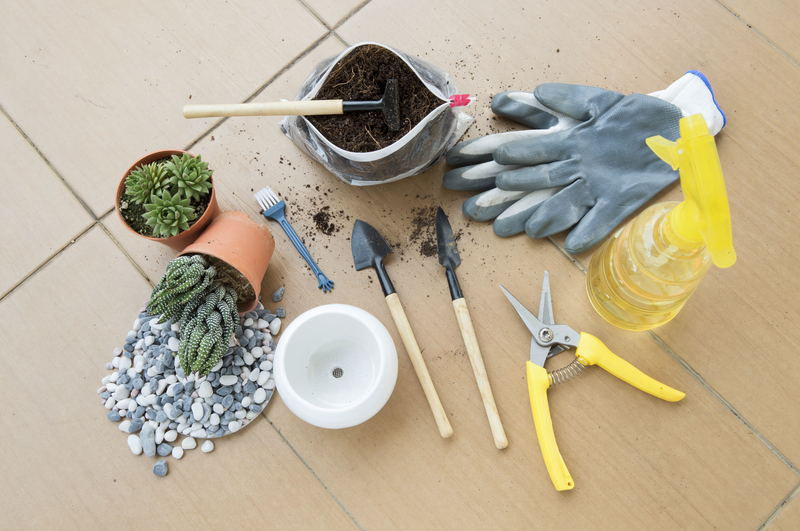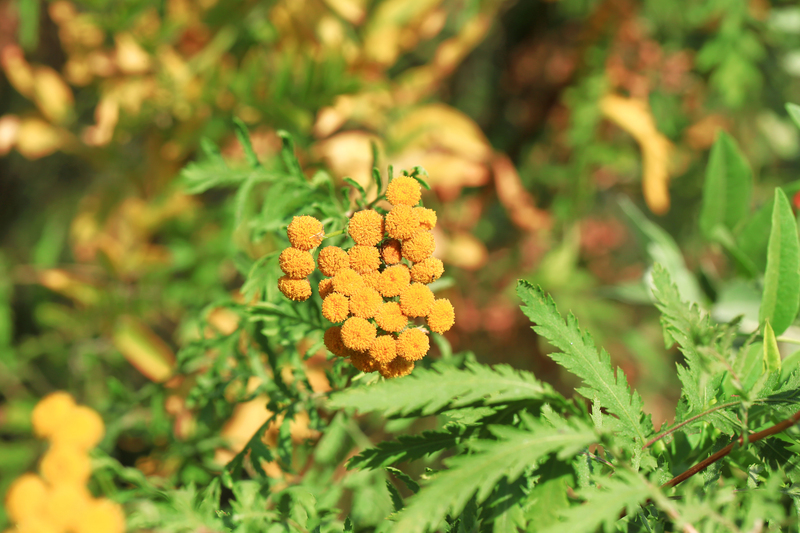Container Gardening: Where Creativity and Nature Flourish Together
Posted on 08/10/2025
Container Gardening: Where Creativity and Nature Flourish Together
In today's urban landscapes, where green spaces are often limited, container gardening has emerged as a vibrant solution for both gardening enthusiasts and beginners. Whether you're blessed with a sprawling backyard or a modest balcony, container gardening allows creativity and nature to thrive hand in hand. In this comprehensive guide, you'll discover everything you need about flourishing with container gardening, from plant selection to arrangement, design tips, and maintenance.
What is Container Gardening?
At its core, container gardening is the practice of growing plants--flowers, herbs, vegetables, or even trees--in containers instead of planting them directly in the ground. The containers may range from classic terracotta pots to repurposed household items, offering unlimited possibilities for creative expression.
Key Benefits of Container Gardening
- Space Efficiency: Ideal for apartments, patios, balconies, and rooftops.
- Design Flexibility: Easily rearrangeable to update your outdoor decorating scheme.
- Soil and Pest Control: Enables precise management, reducing the risk of diseases and weeds.
- Accessibility: Great for individuals with physical limitations, as containers can be elevated.
- Year-Round Gardening: Moveable containers let you extend growing seasons indoors.

Choosing the Right Containers for Your Garden
The first step in container gardening is selecting the right vessel for your plants. The options are extensive--pots, tubs, barrels, crates, and even upcycled items. Each offers unique advantages and aesthetics. When choosing containers for your creative garden, consider the following:
- Material: Containers are made from clay, ceramic, plastic, metal, wood, or fabric. Each material offers different drainage and insulation properties.
- Size: Ensure your container offers ample room for root growth. Herbs thrive in shallow pots, but vegetables may need deep containers for healthy roots.
- Drainage: Containers must have holes to prevent waterlogging--critical to healthy gardening in small spaces.
- Weight: Consider where you'll place your container. Heavy pots may not suit balconies.
- Style: Let your creativity shine! Mix and match colors, textures, and shapes to showcase your personality.
Creative Container Ideas
- Repurposed household items like teacups, old boots, or kitchen colanders
- Hanging baskets for vertical interest
- Tiered wooden ladder shelves packed with assorted pots
- Recycled wooden crates for rustic appeal
- Modern, minimalist geometric planters
Soil and Drainage: The Foundation of Flourishing Container Gardening
High-quality potting mix is vital for containers--never use regular garden soil, as it compacts easily, hinders drainage, and may introduce pests. Look for mixes tailored to your plants (e.g., cacti mixes for succulents or organic blends for edible plants).
Water management is crucial in container gardening arrangements. A layer of small stones or broken pottery at the bottom of your pot can help improve drainage. Ensure all containers have adequate drainage holes to avoid root rot and ensure plant health.
Selecting the Best Plants for Your Container Ecosystem
The joy of container gardening lies in its variety. From culinary herbs to vibrant annuals, compact vegetable species, or even small fruit trees--the choices are nearly limitless. When planning your garden, take note of the following:
Factors to Consider When Selecting Plants
- Sunlight: Assess your space. Is it full sun, partial shade, or mostly indoors?
- Plant Compatibility: Combine varieties that thrive in similar conditions (e.g., Mediterranean herbs like rosemary and thyme).
- Water Needs: Group drought-tolerant options or moisture-lovers together in different pots.
- Growth Habits: Pair upright, spiky plants with trailing or cascading species for dynamic visual interest.
- Seasons: Plan for all-season beauty by mixing annuals, perennials, and bulbs.
Popular Plants for Container Gardens
- Herbs: Basil, mint, parsley, oregano, and chives provide culinary delight and lush greenery.
- Vegetables: Lettuce, cherry tomatoes, peppers, radishes, and dwarf carrots are easy choices for containers.
- Flowers: Petunias, pansies, geraniums, marigolds, and begonias offer vibrant colors season after season.
- Succulents and Cacti: Low-maintenance, drought-tolerant, perfect for sunny windowsills or patio tables.
- Dwarf Fruit Trees: Citrus, figs, or olives lend a Mediterranean vibe to patios or decks.
Designing Your Container Garden: Creativity Unleashed
Container gardening is a canvas for creativity. You're not limited to basic arrangements--instead, use colors, textures, and plant forms to craft stunning displays. Here are some inspiring tips:
Classic Design Formulas
- Thriller-Filler-Spiller: Choose a bold "thriller" plant as your centerpiece (like canna lily), surround it with "fillers" (compact, bushy plants), and trail "spillers" (such as ivy or sweet potato vine) over the sides.
- Monochromatic Arrangements: Play with shades of a single color for an elegant, restful effect.
- Edible-In-Visual Harmony: Intermix herbs and edible flowers with ornamental foliage and blooms for dual-purpose beauty.
- Height Variation: Layer taller plants in the center or back, with shorter varieties at the edges.
- Texture Play: Combine waxy, fuzzy, spiky, and smooth-leaved plants for sensory interest.
Color Coordination Tips
- Complementary colors: Create energy by pairing opposites on the color wheel, such as purple and yellow.
- Analogous shades: Use adjacent colors for harmony, like blue, green, and teal.
- Foliage focus: Remember that colorful leaves can be just as eye-catching as blooms. Try coleus, heuchera, or caladium.
Container Gardening Maintenance: Nurturing Your Living Art
Consistent care is key to flourishing container displays. Although maintaining a container garden is often more manageable than in-ground gardening, a few specific practices ensure your green creations remain healthy and vibrant:
Watering Tips
- Monitor Moisture: Container soil dries out faster than ground soil. Check regularly, especially in hot weather, and water deeply when needed.
- Morning Routine: Water early to limit evaporation and reduce fungal risks.
- Self-Watering Pots: Consider for busy schedules or indoor arrangements.
Fertilizing Your Garden Containers
- Slow-Release Fertilizers: Mix into soil at planting time for months of steady nutrition.
- Liquid Feeds: Supplement once or twice a month during active growth.
- Specialized Foods: Use fertilizers formulated for specific needs, such as tomatoes, citrus, or flowering plants.
General Maintenance and Troubleshooting
- Pruning: Trim faded flowers and leaves for neatness and continuous blooming.
- Pest Control: Inspect plants weekly for aphids, spider mites, or fungal spots; treat promptly with organic solutions.
- Repotting: Refresh soil and upsize pots every 1-2 years to support ongoing plant health.
Going Vertical: Maximize Impact with Vertical Container Gardening
Vertical container gardening is perfect for those who want to maximize color and harvest in a compact footprint. Ideal for balconies, patios, and urban environments, vertical gardens use shelves, stacked pots, wall-mounted planters, or trellises for climbing plants. This approach not only saves space but transforms bland walls into green focal points.
Popular Vertical Container Plants
- Trailing flowers: nasturtium, lobelia, petunia
- Climbing veggies: peas, beans, tomatoes
- Hanging harvests: strawberries and lettuce
- Ornamental vines: sweet potato, English ivy, philodendron
Seasonal Container Gardening: Enjoy Nature's Changes Year-Round
The flexibility of container gardening allows you to celebrate the beauty of every season. With a mindful selection of plants, you can keep your containers lush and visually appealing throughout the year.
Spring
- Fill with tulips, daffodils, and pansies for a burst of early color.
- Start cool-season vegetables like lettuce and snap peas.
Summer
- Emphasize heat-loving flowers such as zinnias and geraniums.
- Grow compact tomatoes, peppers, and basil in sunlit spaces.
Autumn
- Transition to mums, asters, and ornamental cabbages.
- Rotate in kale and pansies for late color and greens.
Winter
- Use evergreens, dwarf conifers, and hellebores for cold-hardy interest.
- Add festive decor like pinecones, red branches, and fairy lights.
Eco-Friendly and Sustainable Container Gardening
Embracing sustainable container gardening is more important than ever. Eco-conscious choices can minimize environmental impact and enrich your gardening experience.
- Use Organic Potting Soil: Reduces chemical runoff and supports healthy microbes.
- Repurpose or Upcycle Containers: Give second life to old items instead of buying new.
- Rainwater Harvesting: Use stored rain to water your plants and conserve water.
- Compost: Add compost to your soil mixes to enrich growth naturally.
- Native and Pollinator-Friendly Plants: Attract bees and butterflies, supporting local biodiversity.
Tips for Successful Container Gardening for Beginners
New to the container gardening world? Don't worry! Here are essential beginner tips to ensure your garden flourishes:
- Start Small: Begin with a handful of containers and gradually expand as you grow confident.
- Choose Easy Plants: Try herbs like mint or basil and flowers like marigolds that are forgiving and rewarding.
- Read Plant Labels: Pay attention to sunlight and water requirements for best results.
- Experiment: Don't be afraid to mix plants or try quirky container ideas--creativity is the heart of this gardening style!
- Observe and Learn: Monitor your plants regularly; healthy plants teach you what works for your microclimate.

Conclusion: Let Your Creativity and Nature Flourish
Container gardening is truly where creativity and nature flourish together. It empowers you to shape your own living masterpiece regardless of space constraints, time, or climate. Whether you seek a rainbow-hued patio, a mini herb kitchen, or a vertical green wall, the possibilities are as boundless as your imagination.
Embrace this rewarding gardening style--experiment, observe, and most importantly, enjoy the journey. With container gardens, you'll discover that bringing nature close and letting your creative spark thrive is within everyone's reach.
Frequently Asked Questions about Container Gardening
1. How do I prevent my container plants from drying out too quickly?
Use a high-quality potting mix, mulch the soil surface, and consider self-watering pots. Larger containers tend to retain moisture better.
2. Can I reuse old potting soil in my containers?
It's best to refresh the mix each season by removing about half of the old soil, replacing it with new, and adding compost for nutrients.
3. How often do I fertilize my container gardens?
Generally, feed with a balanced liquid fertilizer every 2-4 weeks during active growth. Avoid over-fertilization, as it can harm your plants.
4. What are the best vegetables for a container garden?
Cherry tomatoes, lettuce, radishes, peppers, beans, and bush cucumbers all perform beautifully in pots and planters.
5. Can I start a container garden if I only have a small balcony?
Absolutely! Use vertical planters, railing boxes, and hanging baskets to maximize your growing space.
Ready to let your creativity and nature flourish together? Start your own container gardening adventure today and unlock the limitless joy of growing your world--one pot at a time!

